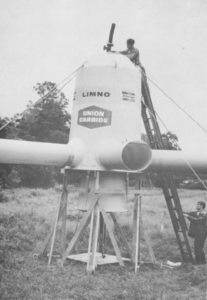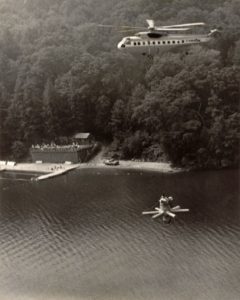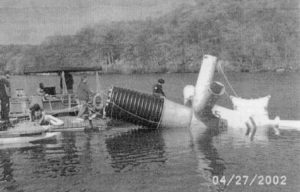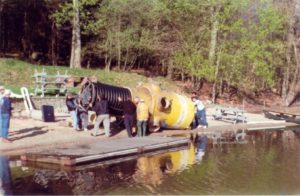Our deep waters lack oxygen
As our lakes thermally stratify each year, the level of dissolved oxygen in the hypolimnion, the bottom of the lake below the thermocline, drops to almost zero. This anoxic state allows phosphorus from the sediment to enter the water column. See more about thermal stratification. Aeration, the process of artificially raising the levels of dissolved oxygen in these waters, can help offset the effects of eutrophication. Aerators are more popular in Europe, where chemicals to control weeds and algae are more strictly regulated than in the US. Our lakes become stratified and deep waters become anoxic early in the spring. Generally the deep waters below 15 to 20 feet lack dissolved oxygen until late November when the lake turns over. By adding oxygen to this lower layer, aeration removes organic debris by encouraging bacterial action in the sediments, binds phosphorous to the sediment to prevent it from leaching into the water column and proving nutrients for algal growth, and provides cold oxygenated water to enhance a cold water or salmonid (trout) fishery.
Union Carbide’s role
 In 1972, Union Carbide was planning to expand aeration in the United States. The company chose three sites to demonstrate various technologies: a reservoir near Attica, New York, a quarry in Ottoville, Ohio, and Lake Waccabuc. The first two pumped water from the lakes and applied pure oxygen to the water before it was returned to the bottom of the lake. In 1973, Union Carbide installed two aerators made by Altas-Copco in the deeper parts of Lake Waccabuc and pumped compressed air to the units from a compressor on shore. Lake Oscaleta served as a control lake to compare changes when the aerators were running.
In 1972, Union Carbide was planning to expand aeration in the United States. The company chose three sites to demonstrate various technologies: a reservoir near Attica, New York, a quarry in Ottoville, Ohio, and Lake Waccabuc. The first two pumped water from the lakes and applied pure oxygen to the water before it was returned to the bottom of the lake. In 1973, Union Carbide installed two aerators made by Altas-Copco in the deeper parts of Lake Waccabuc and pumped compressed air to the units from a compressor on shore. Lake Oscaleta served as a control lake to compare changes when the aerators were running.
Union Carbide operated the system from 1973 to 1975. At that point it turned over ownership and operations to the Three Lakes Council. The council continued operating the system from Memorial Day to Labor Day each year through 2004. During that time the aerators went through two rebuilds to replace the bubblers in the bottom of the units and the compressor was also replaced twice. In the fall of 2001, the aerators were refitted again to increase their efficiency by extending the length of the bottom of the aerator and installing new fine diffusion bubblers. The updated units and a new compressor were reinstalled in the lakes in 2002.
Results 
So what happened? First the good news. Initially, oxygen levels in the hypolimnion were improved to levels that could support a cold water fishery. As part of the Union Carbide study, 2,100 trout were stocked in August, 1973. Creel studies in subsequent years showed that the trout were doing well with normal growth patterns. A second observation was that the chemistry of the hypolimnion had been altered because the hydrogen sulfide (the rotten eggs smell) was being eliminated by the aeration as well.
Now for the not so good news. The first year of operation, there was a 30% decrease in the phosphorous levels in the hypolimnion. The presence of oxygen keeps the phosphorus bound with the sediment. Reduction of this nutrient was a prime goal of the system to help combat eutrification of the lake. However, this phosphorus reduction was not seen after the first year. Union Carbide’s tests to determine what was occurring with the phosphorous were not conclusive. Additionally, data collection was not consistent over the years. However, reports indicated that the system was partially successful in maintaining oxygen levels at least until the early 1990’s.
 Now for the bad news. Except for some final reports, much of the raw data and information gathered has been lost. (Does anyone have some boxes full of paper down in their basement?) This leaves us with gaps in our knowledge to better understand what was really going on in the system. Secondly, operating an aeration system is expensive. Costs were about $10,000 per year for electricity and additional funds were required to repair multiple breakdowns, from broken arms on the unit to broken compressed air hoses and compressor problems. The compressor was replaced in 1988. Finally, the units just could not keep up with the oxygen demand in the lake. A simple indicator is that if the water coming out of the pipe from the aerator smells like rotten eggs, then the aerator isn’t keeping up with the demand for oxygen. And those using the lake in those days remember the smell! In 2004, our testing made it clear that the aerators were not providing any meaningful level of oxygen in the hypolimnion. We made the decision to cease aerator operations in the spring of 2005.
Now for the bad news. Except for some final reports, much of the raw data and information gathered has been lost. (Does anyone have some boxes full of paper down in their basement?) This leaves us with gaps in our knowledge to better understand what was really going on in the system. Secondly, operating an aeration system is expensive. Costs were about $10,000 per year for electricity and additional funds were required to repair multiple breakdowns, from broken arms on the unit to broken compressed air hoses and compressor problems. The compressor was replaced in 1988. Finally, the units just could not keep up with the oxygen demand in the lake. A simple indicator is that if the water coming out of the pipe from the aerator smells like rotten eggs, then the aerator isn’t keeping up with the demand for oxygen. And those using the lake in those days remember the smell! In 2004, our testing made it clear that the aerators were not providing any meaningful level of oxygen in the hypolimnion. We made the decision to cease aerator operations in the spring of 2005.
Conclusion
What’s the future? As currently configured, the aerators cannot keep up with the oxygen demand in the hypolimnion and so we will not power them. It appears that aerators can help sustain a cold water fishery when they operate properly. The suppression of phosphorous leaching has worked in some cases of aeration. However, this comes with a strong caveat that if the aeration is stopped, then all of the phosphorous that has been artificially forced to stay combined with the sediment will start leaching out as soon as the water becomes anoxic. In Lake Waccabuc, the system was operated from Memorial Day to Labor Day, not the full period of stratification. This may have been why the phosphorus results were inconclusive.
The final consideration comes down to cost. To restart aeration, we need to update our data for how much oxygen is required to meet the demand in the hypolimnion. A determination must be made if the units we have can be set up to meet that demand or if some other units would have to be obtained and installed. The cost of operating the system has to be explored including operating for a longer period than in prior years, since we now know that our lakes stratify in April and remain stratified until late November. Finally, if the system cannot suppress the leaching of phosphorus, would we pay for the operation and maintenance of aerators just to support a cold water fishery? Is there a more effective use of the money and attention that this project would demand?
Thanks to Lou Feeney for compiling this information. 
References
Union Carbide Press Release 1973
Three Lakes Council Brochure 1973
Garrell, Skura 1974 Report
Garrell et al 1975 Nutrients
Garrell, Gibbs Final Report 1975
Fast et al, Water Resources Research, 1975